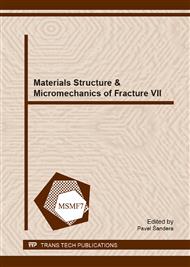p.777
p.781
p.785
p.789
p.793
p.797
p.801
p.805
p.809
The Role of Second Phase Intermetallic Precipitates in Fatigue Fracture Mechanism for Aluminum Alloy AW 7075
Abstract:
This paper presents the results of durability tests of AW7075 aluminium alloy, which is widely used in producing high-durable and particularly reliable constructions in aeronautical and automotive industries. The plain-strain fracture toughness, depending on the orientation of fracture direction with respect to the rolling direction of the material, and the fatigue crack growth rate were determined. Based on scanning electron microscope (SEM) studies the two stages of fatigue fracture are shown: the first is plastic striations and the second is phenomenon of connecting micropores that were formed around intermetallic second phase particles. As a results of research a model of fatigue crack for the second stage is presented.
Info:
Periodical:
Pages:
809-812
Citation:
Online since:
November 2013
Authors:
Price:
Сopyright:
© 2014 Trans Tech Publications Ltd. All Rights Reserved
Share:
Citation:


